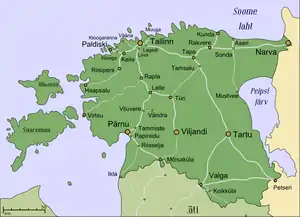Narrow-gauge railways in Estonia
All Estonian narrow-gauge railways were built at the gauge of 750 mm (2 ft 5+1⁄2 in).[1] Four museum lines and some industrial peat railways survive.

Narrow-gauge railway lines in Estonia. Narrow lines on the map represent the narrow gauge. Some lines (Tallinn–Pärnu–Mõisaküla and Lelle–Viljandi) were later replaced by the wide gauge.

A surviving narrow-gauge railway on Naissaar island

Narrow-gauge steam engine Kc4-100 in Tallinn
Railways
- Kunda cement factory, the first narrow-gauge railway in Estonia, built 1886.
- Pärnu–Mõisaküla–Valga line, 121 km, opened 1896.
- Tallinn–Lelle–Türi–Viljandi–Mõisaküla line. 196 km, opened in several stages between 1897 and 1900. Short branch line from Türi to Paide, 14 km, opened 1901.
- Valga–Mõniste–Ape–Alūksne–Gulbene line, opened in 1903.
- Liiva–Vääna, 23 km, part of Peter the Great's Naval Fortress' railway network around Tallinn. The line to Vääna was built in several stages in 1913.
- Paide–Tamsalu, 47 km, built during World War I as a military railway, opened to public passenger and freight traffic in 1918.
- Riisselja–Orajõe, 44 km, opened 1923. In 1928 extended to Ikla, on the border to Latvia (5 km). In 1942 1 km long extension across the border to Ainazi, terminus of the 750 mm (2 ft 5+1⁄2 in) gauge Valmiera supply railway.
- Lelle–Papiniidu (Pärnu), 71 km, opened 1928. 27-km long branch from Viluvere to Vändra.
- Rapla–Virtsu, 96 km, opened 1931.
- Sonda–Mustvee line in northeastern Estonia, 63 km with several branches.
- Järvakandi glassworks, 15 km, industrial
Museums
- The Lavassaare railway museum houses a large collection of steam, diesel and electric locomotives with a 2 km long 750 mm (2 ft 5+1⁄2 in) gauge railway.
- There is a museum with a 750 mm (2 ft 5+1⁄2 in) gauge, 500 m long line in Avinurme which houses one locomotive and a collection of wagons.
- An underground museum with a short electric line is located in Kiviõli in the Northeast-Estonian industrial area.
- A former military railway line with a 750 mm (2 ft 5+1⁄2 in) gauge is located on Naissaar island in the northern Estonia.
This article is issued from Wikipedia. The text is licensed under Creative Commons - Attribution - Sharealike. Additional terms may apply for the media files.